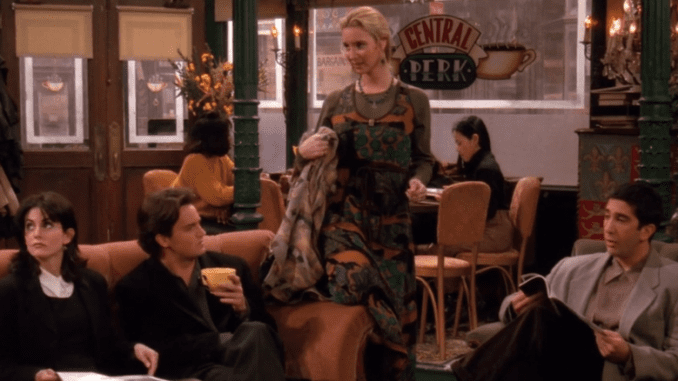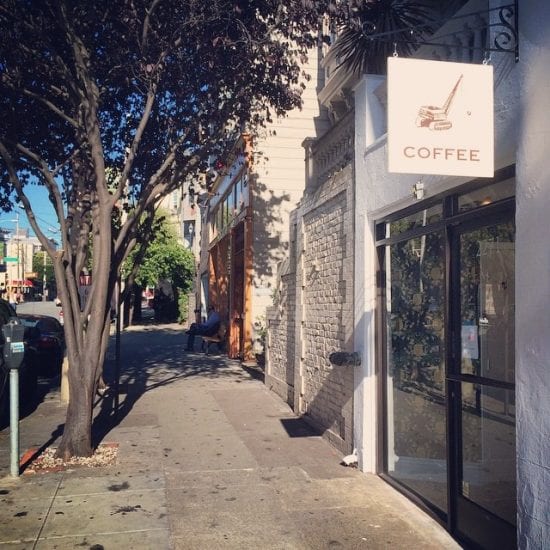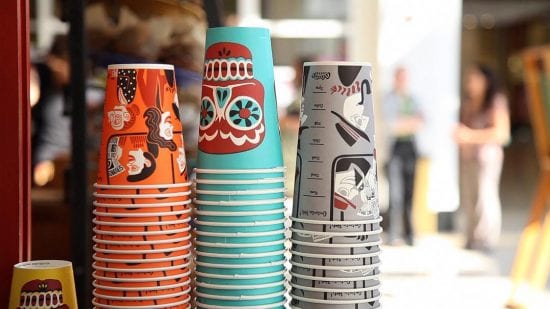
In our last post, we talked about small cups—how cafes have decreased their coffee sizes. This time, we’ll explore the opposite phenomenon: cafes that chose not only to keep larger sizes, but have added them back to their menu.
Larger cup sizes have been, for the most part, erased from most specialty coffee shops. Order a coffee and the largest size you’ll find is a 12-ounce cup. But for many cafes, eliminating larger cups didn’t eliminate the demand for bigger sizes. “We added a 16 ounce ‘secret menu’ option in 2015,” shares Nick Cho of Wrecking Ball Coffee Roasters in San Francisco. “We don’t offer it,” he said, referring to whether or not the option is on the menu. Instead, the 16-ounce cup was a response from customers. “It’s for when it’s clearly what the customer really wants, and now we have regulars that choose it. We started stocking 16 oz. when I realized that people were leaving unhappy because we didn’t have that size. There’s nothing inherently wrong with 16 oz. and it’s something we can accommodate so I made the decision.”

Nick reports that he remembers a shift in cup size offerings happening between 2005-2007. “Lots of shops that opened after around 2005 opened without anything over 12 oz., though often with the exception of cold/iced drinks. Shortly after 2006/2007 you saw shops that had 16 or 20 oz. cups eliminate them,” he remembers. That’s not true of every café, although some stood as outliers in only providing smaller cups. “Actually, Vivace was the only coffee in that town [Seattle] that didn’t offer cups larger than 12 ounces for years and years,” remembers Graeme Lowe, regional retail manager for Sightglass Coffee in San Francisco and former Vivace barista. Recently, however, many cafes have gone backwards and decided that bigger cups do have a place in specialty cafes.
For those coffeeshops, the decision to have or reincorporate larger sizes falls under the same logic Nick uses: we can accommodate it, so why shouldn’t we do it? The argument for larger cups then becomes a question of how much should we listen to the demands of customers—do we stand strong on our beliefs that drinks need to be prepared a certain way, or do we allow our customers to enjoy what they want? “We have both [16 and 20 oz.] sizes at culture. In fact, we added a 20oz for the first time ever about 6 months ago,” shares Johnny Norton, who runs Culture Espresso in New York City.
In some cafes, as we mentioned in the last article, there are ‘rules’ to what can be served in some cups and not in others. At Third Rail Coffee in New York, for example, only coffee can be served in a 16 oz. cup; no espresso drinks are made in that size. There’s a similar rule at Culture, but there aren’t very many other restrictions: “20 oz. is drip only and that’s our one and only ‘rule.’ Other than that, I’ll make you a 16 oz. espresso, steamed milk and vanilla syrup and call it whatever you want,” Johnny shares.
In some instances, coffee cup sizes are simply a matter of regional preference. As you’ve probably noted, most of this large cup/small cup debate comes from cities like San Francisco and New York, but what happens when you look at the middle of the country, or small towns? “Oh Milwaukee loves their big cups. We’re an easy 1:10 8oz:16oz,” shares Cody Kinart of Colectivo Coffee. In areas where you can’t afford to lose customers, taking away options is not an option, and many people have come to expect their drinks in larger sizes.

At the end of the day, larger cups sort of symbolize our rededication to customer service and meeting people’s needs. “Everything is two shots across the board,” shares Becky Reeves of BARISTA in Portland, describing how BARISTA has always had 16 oz. cups, “so it’s mostly for dilution, but hell if someone wants 14 ounces of milk who am I to stop em.” Even Ken Nye, who was the instigator of the infamously stripped down coffee menu at Ninth Street Espresso, admits that some of the drive to offer less was partially fueled by a barista ethos of uncompromising dedication to traditional drinks—without considering the wants and needs of our customers.
Now, he describes himself and his menu less militant, and more accommodating to what people want to drink. And likewise, many cafes have started to come around to the idea that certain drinks must be served in specific sizes. So where are we going next? How will coffee menus and size options change and evolve, and what does it say about the way our mentality about coffee and service have changed? Next time, we’ll use Ninth Street Espresso as a case study and trace the evolution of their coffee menu over the last ten years, and see what their menu can tell us about how our values have transformed in the coffee industry over time.


Fixed! Thanks for the catch.
The caption for the picture of the cups is wrong. Colectivo is in Milwaukee, Wisconsin not Minneapolis.